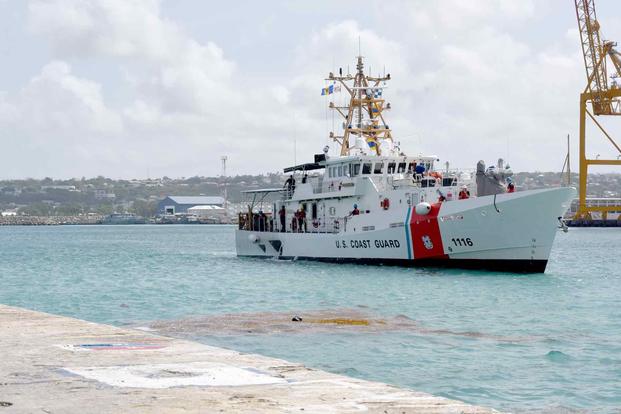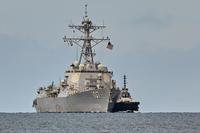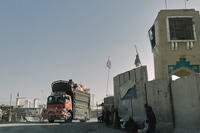The design of the bridge windows on the Coast Guard's fast response cutters and failures by the watch on the cutter Winslow Griesser contributed to the death of a recreational fisherman off Puerto Rico last August, a service investigation has concluded. It also cited the actions of the crew of the 22-foot boat with which the cutter collided.
Results from a major incident investigation published Friday by the Coast Guard found that the two fishermen aboard a 22-foot center console recreational boat, the Desakatado, failed to yield right of way to the cutter Winslow Griesser, resulting in a collision that killed Puerto Rican resident Carlos Rosario and injured his brother, Samuel Rosario Beltrán.
But the investigation also found there was "sufficient evidence" that the Winslow Griesser did not maintain a proper lookout or a safe speed that might have made the Aug. 8, 2022, accident preventable.
Read Next: Air Force Is Cutting Pay for Tough Jobs But Won't Say Which Roles Are Losing Out
The accident led to the relief of its commanding officer, Lt. Cmdr. Benjamin Williamsz, a 2013 graduate of the U.S. Coast Guard Academy who previously commanded the patrol boat Adak.
According to the investigation, the 154-foot Winslow Griesser left San Juan the morning of Aug. 8 heading west for Punta Cana, while the Desakatado headed north to a fishing buoy near Dorado, Puerto Rico.
The skies were clear, but the seas were choppy, with 6- to 8-foot waves and wind gusts up to 22 knots.
As the Winslow Griesser left San Juan, it revved up to 29 knots -- a normal practice at Coast Guard Sector San Juan to save time, limit crew fatigue and relieve other cutters on duty -- even as the operational plan called for 16 knots, according to the Coast Guard.
Williamsz was on the bridge, as was an officer of the deck and quartermaster of the watch. The officer of the deck was fully qualified and was instructing a crewmember on how to perform a watch. Sea spray was clouding the windows, but members of the crew were monitoring radar and had good visibility across the deck, according to the report.
At roughly the same time, the Desakatado, which lacked radar or an automatic transmission system that would have made it detectable to maritime equipment, headed north, bobbing in and out of the large waves. As it reached its fishing grounds, the craft slowed to 5 knots and the crew started preparing lines to fish, paying little attention to the seas around them, according to the investigation.
Shortly after two in the afternoon, the Desakatado, on a course to cross in front of the Winslow Griesser from the port side, was struck by the Coast Guard ship.
The rules of the maritime road say that ships on the starboard side have the right of way, while the general rule of thumb for most mariners is that smaller boats should always give way to larger ones.
The Desakatado failed to do either.
But in his report, Vice Adm. Kevin Lunday, Atlantic Area commander, noted mistakes on the Coast Guard vessel that prevented the cutter from anticipating the accident or taking corrective measures to avoid it.
This included the officer of the deck remaining stationary in the middle of the helm, subject to blind spots created by the bridge's metal window frames, instead of walking around to get a full picture of the horizon.
Lunday also said that the cutter's speed was a factor in failing to prevent the accident, even as he did not rule that the cutter was traveling at an unsafe speed.
"While the sea state played a factor in restricting the visibility for small vessels when they dip below swell height, I do not believe it necessitated either vessel to reduce speed for the prevailing conditions," Lunday wrote.
Nonetheless, based on the findings, Lunday concluded that the accident was caused because neither the cutter nor the recreational boat saw the other. As a result, Williamsz's temporary relief was made permanent in May.
As part of the investigation, Lunday's team interviewed crewmembers, conducted simulations and spoke with a passenger on an American Airlines flight who watched the whole thing unfold as the aircraft approached Luis Muñoz Marín International Airport in San Juan.
Williamsz, the officer of the deck and the quartermaster of the watch, who were not identified in the report, declined to be interviewed for the investigation on the advice of their attorneys.
Williamsz is now assigned to a duty station in Washington while Lt. Vincent Deegan has been named as the cutter's commander, according to a Coast Guard press release.
"The public rightly expects the Coast Guard as professional mariners to maintain and emulate the highest standards of prudent seamanship and navigation," Lunday wrote in his report. "We did not do so here with tragic consequences for members of the public we serve. We will do better."
-- Patricia Kime can be reached at Patricia.Kime@Military.com. Follow her on Twitter @patriciakime.
Related: US Coast Guard Says Debris Field Has Been Found near the Titanic During Search for Submersible












